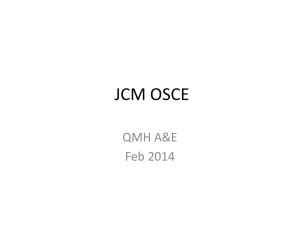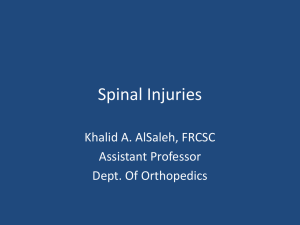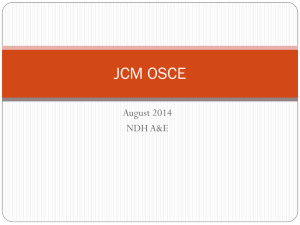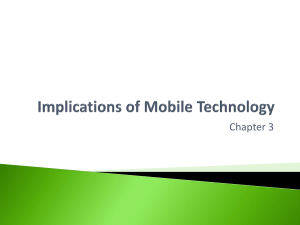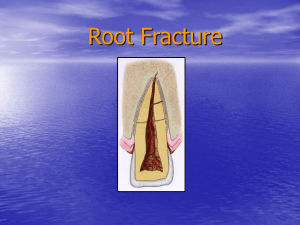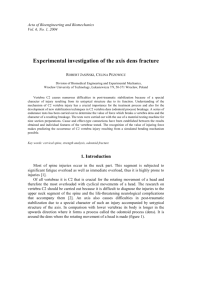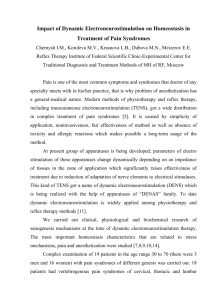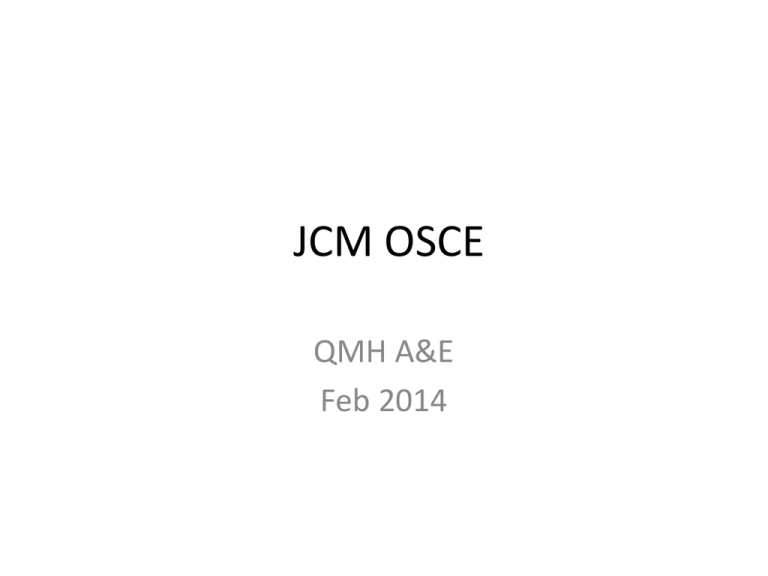
JCM OSCE
QMH A&E
Feb 2014
Case 1
•
•
•
•
•
F/32
LBP for one week
No fever, no neurological deficits
PE unremarkable
Xray LS spine
Case 1
Question 1
• What is the Xray finding?
• What could be the DDx?
Question 2
• What could be causative organism?
Xray Findings
• Loss of L2/L3 disc height.
• Erosion with increase sclerosis noted at L2 and
L3. Increase left psoas shadow is seen. Pedicle
is still preserved.
DDx
• Infective vs malignancy
• Infective more likely in view of increased
psoas shadow and patient’s age
Infective spondylo-discitis
• Infection that involves 1 or more of the
extradural components of the spine
• Organisms:
• Staphylococcus aureus (in 60% of patients)
and Enterobacter species
• Tuberculosis
• Fungal (cryptococcus), in immocomprised
patient
Progress
• Admitted to orthopaedics
• CT guided drainage
• Pus x C/ST: +ve for AFB
• Undergoing Anti- TB treatment
Case 2
•
•
•
•
•
M/20
Complained of R sided chest pain for one day
No SOB
No history of trauma
PE showed decreased breath sound over R
lung
Questions
• What are the findings?
• How do you manage him?
• What are the indications for surgical
treatment?
Xray finding
• R hydropneumothorax
• Trachea and mediastinum is shifted to L side
• Absence of pneumomediastinum
Management
• Haemodynamic support, oxygen
• Early CTS consultation, may need early
thoracotomy
• Insertion of large bore chest drain (>32 Fr)
• Blood (include type and screen)
Indication for surgical treatment
•
•
•
•
•
•
•
Signs of hypovolemic shock
Continuous bleeding (>100mL/hr)
Persistent air leak
Persistent pneumothorax
Impaired lung expansion
Pachypleuritis
Different from ATLS guideline for traumatic
haemothorax (>1500mL first drain or 200mL/hr for
>2hr)
Progress
• Chest drain inserted, blood drained
• Consulted CTSU
• emergency VATS clot evaculation, pleurodesis
done
• Discharge D5
Case 3
• F/21
• PMH: Schizophrenia
• Sudden onset of colicky generalised
abdominal pain again since after lunch
• Small amount BO
• PE: abd distension
AXR
Questions
• What are the findings?
• Name a few differential diagnoses
• What is the diagnosis?
Findings
• Coffee bean sign noted with apex pointing
towards LUQ.
• Differential:
– Other causes of intestinal obstruction, e.g. bezoar
formation (hx of schizophrenia), ileosigmoid knot
– Ischemic bowel, ureteric colic, ectopic pregnancy…
• Diagnosis: sigmoid volvulus
Progress
• Flexible sigmoidoscopy and flatus tube
• decompression performed
• Discharged D2
Case 4
•
•
•
•
•
F/50
Found collapsed in hospital canteen
On arrival GCS 14/15
BP 160/70, P 60
Tenderness and swelling over right face
CT face
Questions
• Please describe the CT scan finding
• What do you need to look for in physical
examination?
• If CT scan is not available, what Xray view will
you order? Any pitfall in this view?
CT bone window:
• Fracture of lateral wall and floor of Rt orbit
• Lateral and medial walls of Rt maxillary sinus.
Opacification of Rt maxillary sinus with airfluid(blood) level
Physical Examination
• Signs of extra-ocular muscle entrapment,
especially diplopia on upward gaze
• Signs of ocular injury, including hyphaema,
rupture of eyeball, visual acuity
• Causes of her collapse… and injuries in other
parts of her body
If CT scan is not available, what
Xray view will you order?
• Water’s view
• Pitfall: Maxillary fluid level may not be
appreciated in supine patient lying on
stretcher
Progress
•
-
seen by EYE
no clinical evidence of muscle entrapment
no globe injury
no indication for ocular intervention
• Discharged D4
Case 5
•
•
•
•
•
•
M/77
Trip and fell with head and neck injury
Brief LOC
PE: GCS 15/15
Tenderness over R neck
RUL power 4/5, LUL 5/5
CT brain + neck
CT reconstruction
Questions
• What are the CT findings?
• What do you need to look for in physical
examination
• What is the classification of this injury?
• What are the possible long term complications
in this injury?
• Name 2 clinical prediction rules for predicting
cervical injury requiring Xray
CT findings:
• Fracture odontoid process with posterior
displacement of the upper portion
-> Hangman’s fracture
• Comminuted fracture of the posterior arch of
C1
-> Jefferson fracture
Physical examination
•
-
Signs of spinal cord compression:
Breathing effort (Diaphragmatic breathing)
Limb numbness/weakness
Anal tone
Distended bladder
What is the classification of this injury?
Classified by location of fracture (Anderson and D’Alonzo classification)
o Type I (<5%)
• Tip of dens at insertion of alar ligament which connects dens to
occiput
• Usually stable but may be associated with atlanto-occipital dislocation
o Type II (>60%)
• Most common dens fractures
• Fracture at base of dens at its attachment to body of C2
o Type III (30%)
• Subdentate—through body of C2
• Does not actually involve dens
• Unstable fracture as the atlas and occiput can now move together as
a unit
What are the possible long term
complication in this injury?
o Non-union
o Due to limited vascular supply
o May occur in 30-50% of Type II fractures,
especially in elderly
o Malunion
o Pseudarthrosis
o Neurological deficit from cord injury
Name 2 clinical prediction rules for
predicting cervical injury requiring Xray
• Canadian C-Spine Rules
• NEXUS criteria
Progress
• MRI C spine:
• No significant cord compression at C1/2 level


